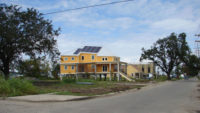Pitt Unveils Sustainable Designs for New Orleans

Pitt Unveils Sustainable Design for New Orleans
Adjaye Associates.
Image Courtesy Make It Right

Pitt Unveils Sustainable Design for New Orleans
Billes Architects.
Image Courtesy Make It Right

Pitt Unveils Sustainable Design for New Orleans
BNIM
Image Courtesy Make It Right

Pitt Unveils Sustainable Design for New Orleans
Concordia
Image Courtesy Make It Right

Pitt Unveils Sustainable Design for New Orleans
Constructs
Image Courtesy Make It Right

Pitt Unveils Sustainable Design for New Orleans
Eskew Dumez Ripple.
Image Courtesy Make It Right

Pitt Unveils Sustainable Design for New Orleans
Graft
Image Courtesy Make It Right

Pitt Unveils Sustainable Design for New Orleans
KieranTimberlake.
Image Courtesy Make It Right

Pitt Unveils Sustainable Design for New Orleans
Morphosis
Image Courtesy Make It Right

Pitt Unveils Sustainable Design for New Orleans
MRVDV
Image Courtesy Make It Right

Pitt Unveils Sustainable Design for New Orleans
Pugh + Scarpa
Image Courtesy Make It Right

Pitt Unveils Sustainable Design for New Orleans
Shigeru Ban.
Image Courtesy Make It Right

Pitt Unveils Sustainable Design for New Orleans
Trahan Architects.
Image Courtesy Make It Right





Post a comment to this article
Report Abusive Comment